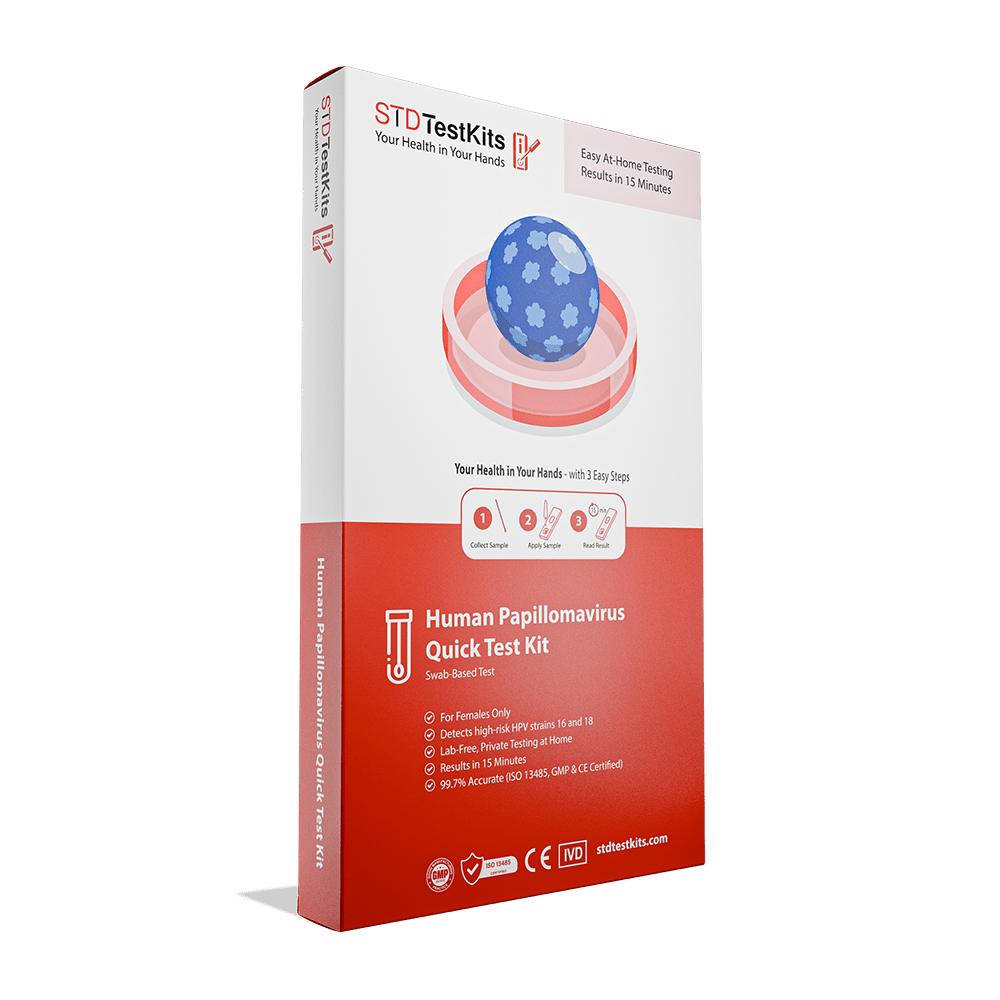STD Risk Checker Quiz: Do You Need to Get Tested?
Quick Answer: Gay men often aren't screened for key STDs like anal HPV, oral chlamydia, or throat gonorrhea unless they request it. Self-advocacy is crucial, and at-home STD testing can help fill the gaps in care.
“I Thought I Got Tested for Everything," But Did You?
Most clinics use the phrase “full STD panel” loosely. For many providers, that still means a urine test for chlamydia and gonorrhea, a blood test for HIV and syphilis, and possibly hepatitis B if you're lucky. But for gay men, the most common places STDs hide, like the throat and anus, aren’t even on the checklist unless you speak up.
Throat gonorrhea and oral chlamydia are often symptomless but contagious. Anal HPV can lead to serious complications like anal cancer. And yet, unless you’re showing visible symptoms (or your provider knows to ask about receptive anal or oral sex), these tests might never be offered.
According to the CDC’s STD screening guidelines for MSM, doctors should screen based on anatomical site of exposure. But research shows that many providers don’t ask those questions, and many patients don’t feel safe volunteering that information. The result? Critical tests are skipped.

People are also reading: I Had Hepatitis C for Years and Had No Idea
What Gay Men Are Actually Getting Tested For
Here’s what typically happens at a standard clinic visit, and what’s usually missing when it comes to gay and bi men’s sexual health.
Table 1. Standard vs site-specific STD testing in MSM. Unless you advocate for oral and anal screening, key infections may go undetected.
“It’s Just a Skin Tag” , How HPV Gets Missed
HPV is the most common STD in the world, and among MSM, it’s nearly universal by age 30. But because many types cause no symptoms, or look like harmless bumps or skin tags, it often goes undiagnosed. Worse, there's no FDA-approved HPV test for men in general, and anal Pap smears are only offered in a handful of clinics.
Daniel, 35, noticed a small, raised bump near his rectum. “I thought it was a hemorrhoid or maybe a skin tag,” he told his doctor. The provider shrugged. “Just monitor it,” he said. Six months later, it had multiplied. A specialist finally confirmed it was high-risk HPV. By then, Daniel was furious.
“I trusted that I was being cared for. No one even looked.”
This kind of dismissal isn’t rare. Many men report being brushed off when they raise concerns about anal symptoms. There’s still widespread ignorance and stigma around gay men’s bodies, and it directly affects care.
Why You Can’t Rely on “They’ll Test Me If I Need It”
Even in LGBTQ-friendly cities, it’s still on the patient to name their risks. Providers often assume heteronormative behavior unless corrected. That means unless you say: “I’ve had receptive anal sex,” or “I perform oral sex,” your doctor may only run the basics, and miss your real risk areas.
It’s not malice. It’s inertia. Many clinicians haven’t been trained to take inclusive sexual histories, and they feel awkward or uncertain. So instead, they skip the conversation and run the default panel. But that leaves you in the dark, especially when:
Table 2. What your sex history means for testing needs. Without this conversation, critical screenings may be skipped.
What Self-Advocacy Looks Like in the Real World
So how do you actually ask for the testing you deserve, without sounding paranoid, being shamed, or getting brushed off? It starts with language, timing, and knowing exactly what to request. You don’t need to explain your identity or behavior in detail if that feels unsafe. But you can state clearly: “I want throat and anal testing for chlamydia and gonorrhea,” or “Can we include anal wart screening?”
Andre, 29, learned the hard way.
“The first time I asked for a rectal swab, my doctor just stared at me like I was speaking another language.”
He now brings a checklist and explains: “I have sex that involves those areas. I want them checked.”
Use firm, non-apologetic language. You don’t owe a performance to prove you’re ‘worth’ testing. And if a provider pushes back or seems unsure, you can reference CDC guidelines directly, or choose an at-home option instead.
Can At-Home STD Testing Fill the Gap?
For many gay men, at-home testing offers something clinics don’t: privacy, control, and site-specific swabs you can choose yourself. No judgment, no awkward conversation. Just accurate answers on your terms.
Modern at-home STD kits now include options for oral and anal swabs, not just urine. Some even test for multiple STDs in one kit, ideal if you’ve had recent exposures or symptoms in multiple areas. And they’re FDA-cleared, fast, and discrete. You swab, ship, and get results in days, not weeks.
STD Test Kits offers several at-home options, including combo kits that screen for chlamydia, gonorrhea, syphilis, and HIV. For those who’ve been denied proper testing before, this can be a game-changer. If you're ready to skip the awkward ask and just get answers.
What to Say at the Doctor’s Office (Script Examples)
Not sure how to start the conversation? Here are a few phrasing options you can use, whether you're seeing a new provider or returning to a regular one:
“I’d like to get tested for all common STDs, including anal and oral testing. Can you make sure that includes throat and rectal swabs?”
“I’ve had receptive anal and oral sex recently. I want site-specific screening, not just urine and blood.”
“Can we check for HPV-related anal warts as part of this visit?”
If they seem unfamiliar with these requests, reference the CDC’s MSM screening recommendations directly. If they still dismiss you, consider changing providers, or switching to home-based kits. Your health isn’t up for debate.
Why This Isn’t Just About You (Community-Level Impact)
STD testing isn’t just personal, it’s public health. Undiagnosed STDs can increase the risk of HIV transmission and reinfection among partners. They can quietly spread through communities, especially when asymptomatic, as is often the case with oral and anal infections.
By getting tested and advocating for thorough care, you're also protecting partners, breaking chains of silent transmission, and helping normalize what should already be routine. The shame isn't in asking. The shame is that you had to.
Javier, 40, puts it this way:
“I used to feel embarrassed every time I asked for a throat swab. Now I think of it like flossing. It’s just part of staying healthy.”
Your body deserves care without conditions. And your voice deserves to be heard in every exam room, especially when silence puts your health at risk.
When to Test, Retest, or Push for More
Let’s talk timing. Many people assume testing right after sex is enough. But most STD tests rely on window periods, the time between exposure and when the infection becomes detectable. Test too early, and you might get a false negative even if you were infected.
Here’s a practical breakdown of testing timing for gay and bi men, especially if oral or anal sex was involved:
Table 3. Optimal testing windows by infection type. Testing too early may miss infections, retesting can offer peace of mind and clarity.
What If the Doctor Says “You Don’t Need That”?
Here’s the truth: plenty of well-meaning doctors still say things like “we don’t test for that” or “you’re probably fine.” But when it comes to STD testing in gay men, “probably fine” doesn’t cut it.
That’s when you can say something like:
“With respect, I know these infections are common in men who have sex with men, and I want to rule them out.”
Or:
“It’s not about symptoms. I’d feel safer knowing I was tested properly for the areas involved.”
And if you’re still met with resistance? That’s your signal. You’re not being “difficult.” You’re being smart. Get a second opinion, or get tested at home.
Let’s Talk Cost, Insurance, and Privacy
Another barrier gay men face when seeking full STD panels is cost. Many insurance plans only cover standard tests, and even then, only if you check the right boxes. Anal swabs, throat tests, or wart screening may be considered “optional” or “non-essential” unless you report specific symptoms.
This leaves many men either under-tested or facing out-of-pocket fees for tests they should be getting for free under public health guidance. It’s frustrating. It’s also why at-home testing has surged: no insurance loopholes, no paperwork, no judgment. Just the tests you choose, delivered to your door, usually for less than a clinic visit would cost uninsured.
When It’s More Than Just a Test, Dealing With Stigma
For a lot of gay men, asking for an STD test is more than just a health question; it's a trigger for past trauma. In the past, some were let go. Some people were told that their sex lives were "high risk" or "deviant." Some people were told they couldn't test unless they begged.
It's not your fault. There is a real stigma around medicine. A 2024 study published in the Journal of Sexual Health found that more than 37% of MSM felt judged or ignored during a medical visit for an STD. That has an effect on trust, follow-through, and results.
You deserve care that respects who you are, your right to make your own decisions, and listens without bias. It's not unreasonable to expect that from your provider. You're getting by in a broken system. Not talking isn't the answer. There are options, like private testing, clear checklists, and scripts that everyone in the community can use.

People are also reading: My STD Symptoms Vanished. Was I Cured, Or Just Lucky?
FAQs
1. Isn’t a “full panel” supposed to catch everything?
You’d think so, right? But nope. Most clinics run a “standard” panel that skips throat and anal testing completely, unless you ask. So if you’ve had oral or anal sex and no one swabbed those areas? You might still be flying blind.
2. Can I really have an STD and not know it?
Absolutely. In fact, that’s half the problem. Oral chlamydia? Usually silent. Anal gonorrhea? You might feel fine, or maybe just a little itchy and think it’s nothing. HPV? Could look like a skin tag. Silence isn’t safety. It’s just common.
3. What’s the deal with HPV testing for guys?
Bad news: there’s no routine, FDA-approved HPV test for men. Good news: some clinics offer anal Pap smears, and you can absolutely request a wart check if you notice any bumps or skin changes. It’s not weird. It’s smart.
4. Do I have to tell my doctor all the details of my sex life?
Only if you want accurate care. You don’t need to narrate positions or partners, just mention what body parts were involved. “I’ve had receptive anal and oral sex” is usually enough to guide proper testing. No apology needed. No shame, either.
5. What if I asked for extra testing and they said no?
You’re not crazy. You’re correct. Some providers just don’t get it, or they don’t listen. That’s not a reflection of you. It’s a red flag about them. Try again elsewhere, or take matters into your own hands with an at-home test that includes what you actually need.
6. How often should I get tested?
Think of it like dental cleanings, but for your sex life. Once a year minimum if you’re monogamous. Every 3–6 months if you’re dating, exploring, or just want peace of mind. If something feels off, or you’ve had a new partner, don’t wait.
7. Do at-home tests actually work?
Yes, and they’ve gotten really good. The swabs are easy, instructions are clear, and you don’t have to explain yourself to anyone. For throat and anal testing especially, they let you cover what clinics often skip. Fast, private, legit.
8. What if my partner doesn’t want to get tested?
That sucks, and it’s a conversation worth having. Testing is about care, not accusation. You can suggest doing it together, or even order a pair of kits. If they still refuse, you’ve got some thinking to do. Your health comes first.
9. Can I still get an STD if I wear condoms?
Yes, you can. Condoms lower the risk, but they don't stop everything, especially skin-to-skin STIs like herpes or HPV. They're not a magic shield; they're protection. Even if you finish it every time, testing is still important.
10. How do I bring this up with a new partner?
Try: “I test regularly, how about you?” It’s not a confrontation. It’s a check-in. If someone gets defensive, that tells you something. If they’re chill, great, you just leveled up your trust and safety. Good sex includes honesty.
You Deserve Answers, Not Assumptions
Here’s the hard truth: the system still doesn’t serve gay men the way it should. Too many infections go undiagnosed. Too many questions go unasked. And too many men walk out of clinics thinking they’re “all clear” when no one even checked the places that matter.
But here’s the hopeful part: you don’t have to wait for the system to catch up. You can ask for what you need. You can choose a provider who listens, or skip the waiting room and test on your own terms. Because when it comes to your sexual health, silence is not the answer. Self-advocacy is.
Don’t wait and wonder, get the clarity you deserve. This at-home combo test kit checks for the most common STDs discreetly and quickly.
Sources
1. CDC
2. CDC
3. ASHA
4. Healthline
5. Mount Sinai
6. BCCDC
How We Sourced This Article: We combined the latest CDC screening recommendations, peer-reviewed studies on testing gaps in gay and bi men, and firsthand reporting from LGBTQ health advocates. Our goal was to demystify STD testing and offer concrete ways to advocate for the care you deserve. Every external link in this guide opens in a new tab so you can explore sources without losing your place.
About the Author
Dr. F. David, MD is a board-certified infectious disease specialist who works to stop, diagnose, and treat STIs. He combines clinical accuracy with a straightforward, sex-positive approach and wants to make it easier for people in both cities and rural areas to read.
Reviewed by: Jordan Hale, MPH | Last medically reviewed: September 2025
This article is for informational purposes and does not replace medical advice.






